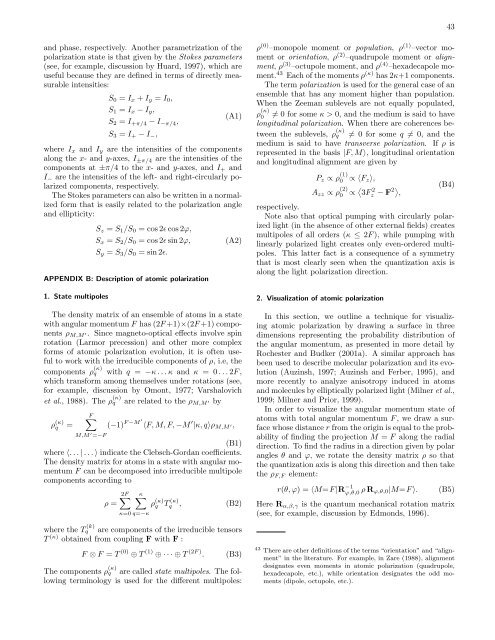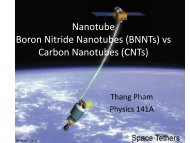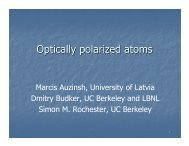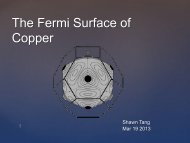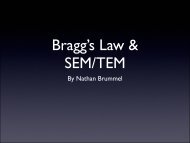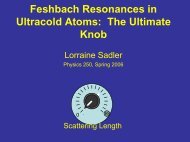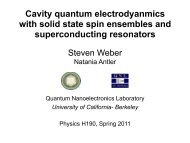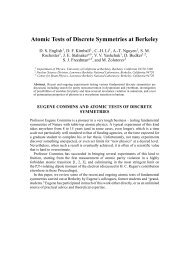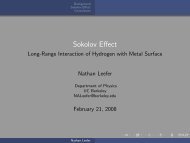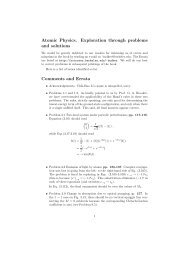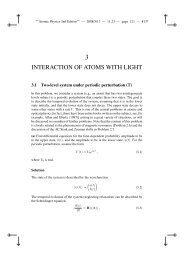Resonant nonlinear magneto-optical effects in atomsâ - The Budker ...
Resonant nonlinear magneto-optical effects in atomsâ - The Budker ...
Resonant nonlinear magneto-optical effects in atomsâ - The Budker ...
You also want an ePaper? Increase the reach of your titles
YUMPU automatically turns print PDFs into web optimized ePapers that Google loves.
43<br />
and phase, respectively. Another parametrization of the<br />
polarization state is that given by the Stokes parameters<br />
(see, for example, discussion by Huard, 1997), which are<br />
useful because they are def<strong>in</strong>ed <strong>in</strong> terms of directly measurable<br />
<strong>in</strong>tensities:<br />
S 0 = I x + I y = I 0 ,<br />
S 1 = I x − I y ,<br />
S 2 = I +π/4 − I −π/4 ,<br />
S 3 = I + − I − ,<br />
(A1)<br />
where I x and I y are the <strong>in</strong>tensities of the components<br />
along the x- and y-axes, I ±π/4 are the <strong>in</strong>tensities of the<br />
components at ±π/4 to the x- and y-axes, and I + and<br />
I − are the <strong>in</strong>tensities of the left- and right-circularly polarized<br />
components, respectively.<br />
<strong>The</strong> Stokes parameters can also be written <strong>in</strong> a normalized<br />
form that is easily related to the polarization angle<br />
and ellipticity:<br />
S z = S 1 /S 0 = cos 2ɛ cos 2ϕ,<br />
S x = S 2 /S 0 = cos 2ɛ s<strong>in</strong> 2ϕ,<br />
S y = S 3 /S 0 = s<strong>in</strong> 2ɛ.<br />
APPENDIX B: Description of atomic polarization<br />
1. State multipoles<br />
(A2)<br />
<strong>The</strong> density matrix of an ensemble of atoms <strong>in</strong> a state<br />
with angular momentum F has (2F +1)×(2F +1) components<br />
ρ M,M ′. S<strong>in</strong>ce <strong>magneto</strong>-<strong>optical</strong> <strong>effects</strong> <strong>in</strong>volve sp<strong>in</strong><br />
rotation (Larmor precession) and other more complex<br />
forms of atomic polarization evolution, it is often useful<br />
to work with the irreducible components of ρ, i.e, the<br />
components ρ (κ)<br />
q with q = −κ . . . κ and κ = 0 . . . 2F ,<br />
which transform among themselves under rotations (see,<br />
for example, discussion by Omont, 1977; Varshalovich<br />
et al., 1988). <strong>The</strong> ρ (κ)<br />
q are related to the ρ M,M ′ by<br />
ρ (κ)<br />
q =<br />
F∑<br />
M,M ′ =−F<br />
(−1) F −M ′ 〈F, M, F, −M ′ |κ, q〉ρ M,M ′,<br />
(B1)<br />
where 〈. . . | . . . 〉 <strong>in</strong>dicate the Clebsch-Gordan coefficients.<br />
<strong>The</strong> density matrix for atoms <strong>in</strong> a state with angular momentum<br />
F can be decomposed <strong>in</strong>to irreducible multipole<br />
components accord<strong>in</strong>g to<br />
ρ =<br />
2F∑<br />
κ∑<br />
κ=0 q=−κ<br />
ρ (κ)<br />
q T q (κ) , (B2)<br />
where the T q<br />
(k) are components of the irreducible tensors<br />
T (κ) obta<strong>in</strong>ed from coupl<strong>in</strong>g F with F :<br />
F ⊗ F = T (0) ⊕ T (1) ⊕ · · · ⊕ T (2F ) .<br />
(B3)<br />
<strong>The</strong> components ρ (κ)<br />
q are called state multipoles. <strong>The</strong> follow<strong>in</strong>g<br />
term<strong>in</strong>ology is used for the different multipoles:<br />
ρ (0) –monopole moment or population, ρ (1) –vector moment<br />
or orientation, ρ (2) –quadrupole moment or alignment,<br />
ρ (3) –octupole moment, and ρ (4) –hexadecapole moment.<br />
43 Each of the moments ρ (κ) has 2κ+1 components.<br />
<strong>The</strong> term polarization is used for the general case of an<br />
ensemble that has any moment higher than population.<br />
When the Zeeman sublevels are not equally populated,<br />
ρ (κ)<br />
0 ≠ 0 for some κ > 0, and the medium is said to have<br />
longitud<strong>in</strong>al polarization. When there are coherences between<br />
the sublevels, ρ (κ)<br />
q ≠ 0 for some q ≠ 0, and the<br />
medium is said to have transverse polarization. If ρ is<br />
represented <strong>in</strong> the basis |F, M〉, longitud<strong>in</strong>al orientation<br />
and longitud<strong>in</strong>al alignment are given by<br />
P z ∝ ρ (1)<br />
0 ∝ 〈F z〉,<br />
A zz ∝ ρ (2)<br />
0 ∝ 〈 3F 2 z − F 2〉 ,<br />
(B4)<br />
respectively.<br />
Note also that <strong>optical</strong> pump<strong>in</strong>g with circularly polarized<br />
light (<strong>in</strong> the absence of other external fields) creates<br />
multipoles of all orders (κ ≤ 2F ), while pump<strong>in</strong>g with<br />
l<strong>in</strong>early polarized light creates only even-ordered multipoles.<br />
This latter fact is a consequence of a symmetry<br />
that is most clearly seen when the quantization axis is<br />
along the light polarization direction.<br />
2. Visualization of atomic polarization<br />
In this section, we outl<strong>in</strong>e a technique for visualiz<strong>in</strong>g<br />
atomic polarization by draw<strong>in</strong>g a surface <strong>in</strong> three<br />
dimensions represent<strong>in</strong>g the probability distribution of<br />
the angular momentum, as presented <strong>in</strong> more detail by<br />
Rochester and <strong>Budker</strong> (2001a). A similar approach has<br />
been used to describe molecular polarization and its evolution<br />
(Auz<strong>in</strong>sh, 1997; Auz<strong>in</strong>sh and Ferber, 1995), and<br />
more recently to analyze anisotropy <strong>in</strong>duced <strong>in</strong> atoms<br />
and molecules by elliptically polarized light (Milner et al.,<br />
1999; Milner and Prior, 1999).<br />
In order to visualize the angular momentum state of<br />
atoms with total angular momentum F , we draw a surface<br />
whose distance r from the orig<strong>in</strong> is equal to the probability<br />
of f<strong>in</strong>d<strong>in</strong>g the projection M = F along the radial<br />
direction. To f<strong>in</strong>d the radius <strong>in</strong> a direction given by polar<br />
angles θ and ϕ, we rotate the density matrix ρ so that<br />
the quantization axis is along this direction and then take<br />
the ρ F,F element:<br />
r(θ, ϕ) = 〈M=F |R −1<br />
ϕ,θ,0 ρ R ϕ,θ,0|M=F 〉.<br />
(B5)<br />
Here R α,β,γ is the quantum mechanical rotation matrix<br />
(see, for example, discussion by Edmonds, 1996).<br />
43 <strong>The</strong>re are other def<strong>in</strong>itions of the terms “orientation” and “alignment”<br />
<strong>in</strong> the literature. For example, <strong>in</strong> Zare (1988), alignment<br />
designates even moments <strong>in</strong> atomic polarization (quadrupole,<br />
hexadecapole, etc.), while orientation designates the odd moments<br />
(dipole, octupole, etc.).


